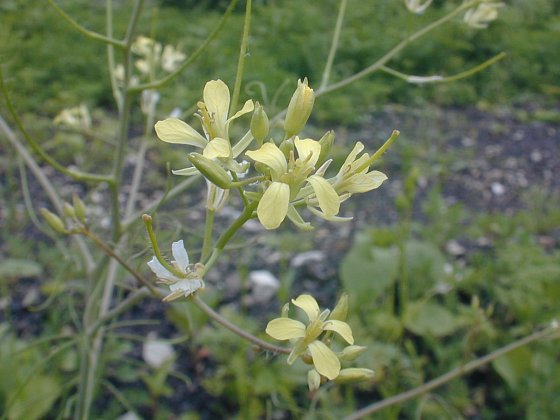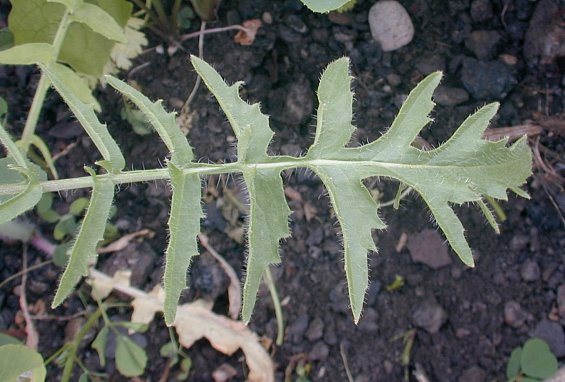Description: This annual or biennial plant is about 2–3½' tall, branching occasionally in the upper half. It is initially a low-growing rosette of basal leaves, but later becomes tall and lanky in appearance. The terete stems are light green and mostly glabrous, except for widely scattered white hairs. The widely-spaced alternate leaves are up to 12" long and 3" across. They are light green and deeply pinnatifid. The margins of their lobes have a few dentate teeth and scattered white hairs. There are also scattered white hairs on the upper and lower surfaces of the leaves, especially along the lower mid-veins. The basal and lower leaves have lobes that are more or less narrow and often triangular in shape. The middle and upper leaves are smaller in size and have lobes that become increasingly linear, while the lobes of the uppermost leaves near the flowers are greatly reduced in size and resemble small linear bracts. The basal and lower leaves have stout petioles that are often purple.

The upper stems terminate in racemes of light yellow flowers. The flowers and their buds are clustered together toward the apex of each raceme, while the elongated seedpods develop below. Each flower is about 1/3" (8 mm.) across, consisting of 4 light yellow petals, 4 light green sepals, a central pistil with a knobby stigma, and several stamens with sagittate (arrow-head shaped) anthers. Both the petals and sepals of the flowers are more narrow than those of many other members of the Mustard family. There are pale veins across the surface of the petals. The blooming period usually occurs during the summer and lasts about 1-2 months. As each flower matures, it becomes transformed into an elongated seedpod (a silique) that is very slender and cylindrical. These seedpods are 2-5" long at maturity, resembling naked upper stems; they are ascending and spreading. At the base of each seedpod is a short petiole about 1/3" (8 mm.) long that has about the same diameter as the seedpod (less than 1/8" or 3 mm. across). Each seedpod contains a single row of seeds (up to 100). The small seeds are smooth, oblongoid-ovoid in shape, and dull orange to dark brown in color, depending on their stage of maturity. This plant often becomes brittle and breaks off at the base, tumbling about in the wind to distribute the seeds. This is the source of the common name. The root system consists of a stout taproot.

Cultivation:
Full sun
and poor soil that is somewhat dry, sandy, or gravelly, are typical
growing conditions for this plant. Open habitats with little vegetation
are preferred. This plant is often a winter annual that develops
quickly during the late spring and early summer to produce flowers by
mid-summer.
Range & Habitat:
The adventive Tumble Mustard is an occasional plant in central and
northern Illinois, but it is uncommon or absent in many areas of
southern
Illinois (see Distribution
Map). This plant is native to North Africa and the western
Mediterranean region of Europe. Habitats include cropland with short
grains, pastures, fallow fields, areas along railroads and roadsides,
and sterile waste areas. In Illinois, Tumble Mustard prefers open
disturbed areas, and it does not invade natural areas to any
significant extent. This may be less true in some of the western states.
Faunal Associations:
The flowers attract small bees and flower flies primarily.
Occasionally, the butterflies Pieris rapae
(Cabbage White) and Pontia
protodice
(Checkered White) visit the flowers for nectar, while their
caterpillars feed on the foliage. Other insects feeding on the foliage
of Tumble Mustard include the leaf beetles Entomoscelis americana,
Phyllotreta cruciferae,
and Phyllotreta
punctulata, and such grasshoppers as Melanoplus foedus
(Striped Sand Grasshopper) and Melanoplus
sanguinipes (Migratory Grasshopper).

Photographic
Location:
Along an abandoned railroad in Urbana, Illinois, where several plants
were growing on dark cindery soil.
Comments:
This is a rather odd-looking member of the Mustard family as the lobes
of the upper leaves are linear, even thread-like in appearance. The Sisymbrium
spp. (Hedge Mustards) belong to a rather large group of
plants within the Mustard family that have yellow flowers and long
narrow seedpods called "siliques." These siliques may be round,
flattened, or 4-angled in circumference, and their endpoints may taper
into stipes or beaks. The siliques of Tumble Mustard are narrowly
cylindrical and they lack either stipes or beaks. Among the Hedge
Mustards in Illinois, Tumble Mustard has the longest siliques, spanning
2" or more in length when they are fully mature. Other Hedge Mustards (Sisymbrium
officinale and Sisymbrium loeselii) in
Illinois have siliques that are less than 2" in length, and the
terminal lobes of their upper leaves are non-linear, often lanceolate
in shape.